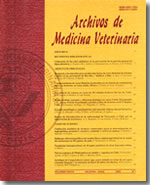Characterisation of milk production systems of Southern Chile under different farm management systems and their relationship with total bacterial count of milk: a multivariate analysis
Main Article Content
Abstract
In this study, different types of dairy management systems for milk production (SP) in Southern Chile were determined and characterised, relating management variables to bacterial count in raw milk. Qualitative information on several management variables was utilised for evaluation. A survey was conducted on 108 dairy farmers and the management systems were evaluated using both multiple correspondence and conglomerate analysis. Four milk production systems were identified. The SP1 group (43% of the surveyed farmers) that delivered 87% of the industry milk had an adequate production management, with 100% of the produced milk being classified as best quality (≤ 20.000 cfu/mL). The SP2 group (20% of surveyed farmers) that produced 10% of the total milk delivered, mainly showed inadequate ways of milk production, however, 77% of the milk was classified as best quality. The uneven results suggest that further in-depth analysis of the group is required. Finally, the SP3 and SP4 groups that produced only 3% of the milk delivered but represented 37% of the surveyed farmers, had inadequate production management and were classified as "problem groups" with low milk quality with bacterial counts > 200.000 cfu/mL for 76% and 72% of the produced milk, respectively; specially the SP3 group with 61% of the milk in the worst quality category (> 800.000 cfu/mL). Therefore, corrective actions, mainly related to milk storage temperature and milking equipment cleaning, are required for the SP3 and SP4 groups.

